Najam Siddiqi1, Firdous Jahan2, Faisal Moin3, Fatima Al-Shehhi4 and Fatima Al-Balushi4
1Department of Anatomy and Neurobiology, Oman Medical College, PO Box 391, Sohar, Sultanate of Oman, 321 In Academic partnership with West Virginia University, Morgantown, USA.
2Department of Family Medicine, Oman Medical College, PO Box 391, Sohar, Sultanate of Oman, 321 In Academic partnership with West Virginia University, Morgantown, USA.
3Department of Medicine, Oman Medical College, PO Box 391, Sohar, Sultanate of Oman, 321 In Academic partnership with West Virginia University, Morgantown, USA.
4Oman Medical College student Oman Medical College, PO Box 391, Sohar, Sultanate of Oman, 321 In Academic partnership with West Virginia University, Morgantown, USA.
DOI : https://dx.doi.org/10.13005/bpj/1274
Abstract
Smart mobile phone usage is rapidly increasing among the students in colleges. Many new symptoms have emerged such as mobile phone addiction, nomophobia and ringxiety among users. The objective of this study was to study the prevalence of mobile phone use by medical students in a medical college in Oman and to see if the students were using their mobile phones safely. A questionnaire was constructed to get basic knowledge about the use of smart phone by the college students. 129 students responded, results showed that 100% of the students were using a mobile device, 50% of the students, who were mostly females, were using internet via WiFi on their mobile for more than 4 hours per day, and majority (83%) were using headphones. During lectures, 85% kept mobile phone ‘on’, 65% sent messages, 20% even played games and 7% received or made calls. While sleeping, 70% did not switch off their phones, 33% kept it under their pillow and 60% on a side table. When asked if their parents limit the use of their phone, 83% say no. 90% of the students were aware of the fact that mobile phones electromagnetic waves may cause health problem. We conclude that there is excessive usage of mobile phone among the medical students and more safety measures need to be introduced. It is time to make new rules and policies regulating its use in the campus to avoid adverse effects.
Keywords
Mobile Phone; Electromagnetic Waves; College Student
Download this article as:| Copy the following to cite this article: Siddiqi N, Jahan F, Moin F, Al-Shehhi F, Al-Balushi F. Excessive use of Mobile Phones by Medical Students: Should Precautions be Taken?. Biomed Pharmacol J 2017;10(4). |
| Copy the following to cite this URL: Siddiqi N, Jahan F, Moin F, Al-Shehhi F, Al-Balushi F. Excessive use of Mobile Phones by Medical Students: Should Precautions be Taken?. Biomed Pharmacol J 2017;10(4). Available from: http://biomedpharmajournal.org/?p=18333 |
Introduction
It has been noticed that college students are spending excessive time on smart phones. Most of the students can be seen holding a smart phone in their hand while attending lectures or doing other activity during the college study hours. Many researchers have reported ‘mobile phone addiction’ referring to such symptoms as ‘nomophobia and ringxiety’.1,2,3 This compulsive behavior is comparable to compulsive gambling and video gaming which have physical and psychological withdrawal symptoms like anxiety, restlessness and irritability.4 Other symptoms such as headaches, earache, warm sensations, concentration difficulties and fatigue have also been reported.5,6 Another new term ‘nomophobia’, an abbreviation for “No-mobile-phone-phobia” was introduced by the UK post Office in 2010, which meant keeping the device in reach while sleeping and never turned off, looking at the phone screen frequently to avoid missing any messages, phone calls or notifications, which is referred to as ringxiety.7 Ritu described the terminology “textaphrenia”, “textiety” “post-traumatic text disorder” and binge texting as newly developing disorders related to smart phone use.8
Social networks such as Facebook, WhatsApp, Instagram, and twitter, installed on smart phones are contributing to mobile phone addiction. Facebook has more than 1.44 billion users in the beginning of 2015, WhatsApp around 800 million with 82% of adolescents and young adults using these social networks regularly.9
Mobile phones use non-ionizing low radio frequency electromagnetic waves (REW). It causes DNA damage,10 affecting genes, membrane function and signal transduction.11,12,13 Functions of the central nervous system, permeability of the blood brain barrier 14 and melatonin synthesis 15 are also affected. REW exposure increases free-radical production which causes metabolic, immunological and carcinogenic effects.17,18 Symptoms such as headaches, sleep disturbances, lack of concentration, dizziness, memory loss, and increased risk of cancer were first reported as “Microwave sickness” in 1978,19 which are now linked to the base stations in the vicinity of residential areas and excessive use of mobile phones. Childhood leukemia in children exposed to extremely low frequency (ELF) magnetic fields has already led to its inclusion as a “possible human carcinogen” by the International Agency for Research on Cancer, published in “Agents Classified by the IARC Monographs”, Volumes1–109. (http://monographs.iarc.fr/ENG/Classification/ClassificationsAlphaOrder.pdf). Recently an increase incidence of thyroid cancer in South Korea and gliomas in Sweden have been reported which could be due to excessive use of mobile phones.20,21
There has been increasing concern of the rising use of mobile phones by the young adults.
Hypothesis
Our hypothesis is that our medical students use mobile phone excessively during and after college working hours.
Objective
To determine the prevalence of mobile phone use by medical college students at Oman Medical College during and after college hours in Sultanate of Oman, and to investigate the ways mobile phones are being used.
Materials and Methods
This study was approved by the ethical committee of Oman Medical College and is part of an internal grant by Oman Medical College to study the prevalence of mobile phone use in schools and colleges in North Al Batinah region of Oman. It is also approved by the Ministry of Health and Ministry of Education, Sultanate of Oman.
This is a cross-sectional type of observational study. A questionnaire (English and Arabic) was constructed on google forms and was send to the students of year 2,3,4, and 5 (pre-med and pre-clinical students). Data was collected and analyzed using SPSS software. The different variables were presented, compared and analyzed using independent t test. A p value of < 0.05 was considered significant.
Results
129 students from classes 2nd, 3rd, 4th and 5th years at Oman Medical College responded to the questionnaire. The age ranged from 17-24 years; 90.7% females. The results showed that 100% of the students were using a smart phone mobile device. Almost 50% of the students who were mostly females were using internet and WiFi on mobile for more than 4 hours per day, 87% using headphones (Fig.1).
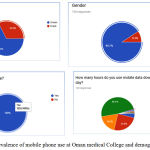 |
Figure 1: Prevalence of mobile phone use at Oman medical College and demographic data
|
Mobile Phone use During Class
When asked if they were turning the mobile device off during lectures, 85% reported no, 65% sent or received messages, 20% played games and 7% received or made a call during lectures (Fig.2). The ways the students used the smart phone is shown in Fig.3.
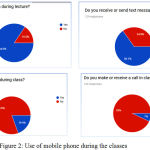 |
Figure 2: Use of mobile phone during the classes
|
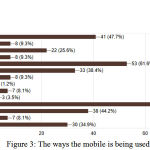 |
Figure 3: The ways the mobile is being used
|
Mobile Phone use During Sleeping Hours
When asked if they switch off the mobile when sleeping, 70% said no, 33% kept it under the pillow and 60% on a side table (Fig4).
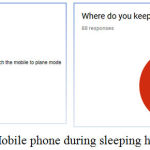 |
Figure 4: Mobile phone during sleeping hours
|
Keeping the Mobile Phone When Outdoors
Majority of the female students kept their mobile phones in their hand or purse while boys kept it in their front pocket (Fig.5).
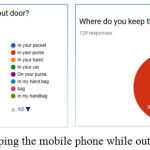 |
Figure 5: Keeping the mobile phone while outdoors
|
Parents limiting use of mobile phone
When asked if their parents limit the use of mobile phone, 83% say no (Fig.6).
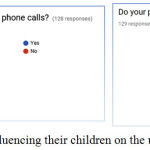 |
Figure 6: Parents influencing their children on the use of mobile phone
|
Knowledge of Electromagnetic Waves Hazards
90% say yes when asked if they know that mobile phone electromagnetic waves may cause health problems (Fig.7).
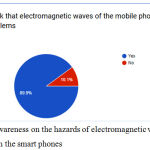 |
Figure 7: Awareness on the hazards of electromagnetic waves emitted from the smart phones
|
Discussion
Prevalence of mobile phone use by young adults is more than 90% and the use in Oman is ranked 10th in the world22,23 (after Saudi Arabia, Russia, Kuwait and Panama, WHO health statistics 2013). In Saudi Arabia, 53.4% of the students owned smart phones, 88% of the students in Kenya owned a mobile phone.24,25
100% of the students at Oman Medical College have their own smart mobile device and 50% of the students are using it more than 4 hours/per day. Datta reported 33% of the students using more than 2 hours/day and he named them as “very frequent users of cell phone|”.1 Rupani reported that 92.7% were highly involved with their mobile phones; 19% labeled as mobile phone addiction.26 Saxena also reported 57% students using smart phones more than 2 hours/day (63.6% females).27 In another study, mean time spent per day on mobile phone was 2.8 hours/day.8 Yadav reported 81% using smart phones and 65% were using more than 2 hours/day .28 Hegazy et al reported 6 hours/day use of mobile phone in Saudi Arabia.29 In USA, it was reported that adults spend 4-6 hours/day with smart phones.30 In another study medical students who were using phones for 75 minutes/day reported symptoms such as headache, whizzing sound in ear, sleep disturbances, loss of attention and arm and neck muscle spasm.31
This use of smart mobile phones via WiFi is now a pandemic and many new symptoms have been reported related to this excessive use.32 It is therefore crucial to know the safety measures to protect yourself from the effects of electromagnetic waves. It is clearly known that using headphone is safer than putting the phone to your ear. Majority of students at OMC were using headphones.
Smart Phone While Sleeping
It has been reported that excessive mobile use is significantly related to sleep disturbances.33 A study from Japan on 94,777 adolescents revealed sleep disturbances, short sleep, poor sleep quality, excessive day time sleepiness and insomnia for those who were using excessive mobile phone for calling or sending text messages until late at night.34 Yogesh et al reported significant association of hours of usage and sleep indices in both males and females, negative association with sleep quality, sleep deprivation and day sleepiness affecting cognitive and learning abilities of medical students.35 Poor sleep quality and quantity was also correlated by high internet and social network usage via smart phones 2 and reduced melatonin production.36 Sahin et al reported sleep quality worsens with increasing the mobile addiction level.37
Keeping the mobile ‘on’ the whole night and placing it under the pillow would continue the exposure of electromagnetic waves to the head region which could be a cause of disturb sleep.
In this study 70% don’t turn the mobile off and 33% keep it under the pillow while sleeping, however, 60% keep it on the bed side table. It is much safer to turn it in “airplane mode” during sleep or disconnect the WiFi and to place it at least 1-2 feet away from the body.
Use in the Class Room
It was interesting to note that students are now using their smart phones during the classes which may distract their attention from the lecture. Majority of the students keep the mobile phone ‘on’ during lectures, 65% receive or send messages, 20% of students play games and 7% make or receive calls which may distract them from concentrating on the lecture being delivered. It has become a routine practice to keep the mobile on during class room sessions. On the other hand many institutes are giving electronic devices to their students to be used during class rooms. Stanford University’s medical school has iPad instead of text books. No overall impact on academic performance was observed by using e-devices.24,38 At the same time moving towards electronic textbooks, electronic data base and routine use of smart phone during their basic class room teaching and clinical ward rounds is encouraged and consided as part of their curriculum.39,40 Here at Oman Medical College, laptops are provided to the students, and WiFi is provided 24 hours to facilitate the students to make use of all the electronic media. However, students mostly misuse the internet and use it more for entertainment and watching movies than pedagogy. It should be advised to switch off the mobile while in a lecture.
Keeping the Mobile Phone
It is important how close to the body you keep the mobile. Putting in the front pocket of trousers by the males may affect their reproductive organs. Many are holding it in their hands which have the risk of bacterial contamination especially in the infectious clinical wards.41,42 High levels of electromagnetic radio-frequency waves are emitted from the mobile sets, so keeping the mobile phone close to the ear while talking may cause side effects due to absorption of the waves into the tissues. Data et all reported 45% students have earache, headache and blurring of vision.1 In a cross-sectional study conducted at Baystate Medical Center in Western Massachusetts, the prevalence of ringxiety (Phantom Vibration Syndrome) was 68% in those who use electronic devices.43 During use of mobile data, REW level is high. We reported in a previous study that head phone with blue tooth (wireless) emit less radiations as compared to using mobile phone directly, however, head phone with wire is the safest option where the data is transferred by a cable. Head phone must be with a good quality wire to reduce radiation. Last but not the least, downloading data from the internet showed significant increase in the radio waves.
Conclusion
100% of the medical students at Oman Medical College are using smart phone during and after their college sessions. Majority of students are using WiFi for more than 4 hours per day. It is being used during lectures, and remains on during the night which exposes the students to electromagnetic waves. College provides WiFi for academic purpose; however, the students may overuse it for entertainment which may expose them to smart phone addiction and other related symptoms. Further studies should be done to access the mobile phone symptoms and to make policies for control the excess use of mobile phone specially for those who are academically performing below expectations.
Acknowledgment
We are thankful to Dr. Muthusami John C, Professor of Surgery, Oman Medical College for his valuable suggestions and Dr. Ajmani ML, Professor of Anatomy and Neurobiology for his continuous support. This study is supported by an Internal Grant from Oman Medical College and there is no conflict of interest.
Reference
- Data S., Nelson V., Simon S. Mobile phone use pattern and self-reported health problems among medical students. J Evolution Med Dent Sci. 2016;5:1116-119.
CrossRef - Mohammad A. B., Absari R., Vallzadeh F., Reza M. S.,et al., Sleep quality in medical students; the impact of over-use of mobile phone and social networks. JRHS. 2016;16:46-50.
- Ezoe S.,Toda M. Relationship of loneliness and mobile phone dependence with internet addiction in Japanese medical students. Open Journal of Preventive Medicine. 2013;3:407-412.
CrossRef - Puente M. P., Balmori A. Addiction to cell phones are they neuro physiological mechanisms involved? Proyecto. 2007;61:8-12.
- Johansson A., Nordin S., Heiden M et al. Symptoms, personality traits and stress in people with mobile phone-related symptoms and electromagnetic hypersensitivity. Journal of Psychosomatic Research. 2010;68:37-45.
CrossRef - Korpinen L. H., Paakkonen R. J. Self-report of physical symptoms associated with using mobile phones and other electrical devices. Bioslectromagnetics. 2009;30(6):431-437.
CrossRef - Bragazzi N. L., Puenete G. D. A proposal for including no mophobia in the new DSM-V. Psychology Research and Behavior Management. 2014;7:155-160.
CrossRef - Ritu N., Natasha K., Sandeep G., Nitasha K. Debasish B. Does the excessive use of mobile phone in young adults reflect an emerging behavioral addiction? J Postgrad Med Edu Res. 2012;46:177-182.
CrossRef - Wilson C., Boe B., Sala A., Puttaswamy K. P., Zhao B. Y. User interactions in social networks and their implications. Proceedings of the 4th ACM European conference on Computer systems. April 1-3, Nuremberg, Germany. 2009.
CrossRef - Aitken R. J., Bennetts L. E., Sawyer D., Wiklendt A. M., King B. V. Impact of radio frequency electromagnetic radiation on DNA integrity in the male germ line. Int J Androl. 2005;28:171–179.
CrossRef - Verschaeve L., Heikkinen P., Verheyen G., Van G. U., et al. Investigation of co-genotoxic effects of radiofrequency electromagnetic fields in vivo. Radiat Res. 2006;165: 598–607.
CrossRef - Donato A., Ceci P., Cannavo A. T. F., Naro F. Low power microwave interaction with phospholipase C and D signal transduction pathways in myogenic cells. Cell Biol Int. 2004;28:683–688.
CrossRef - Maier R. Is CNS activity modified by pulsed electromagnetic fields? Biomed Tech (Berl). 2001;46(1):18-23.
CrossRef - Franke H., Streckert J., Bitz A., Goeke J., Hansen V., Ringelstein E. B., et al. Effects of Universal mobile Telecommunications System (UMTS) electromagnetic fields on the blood-brain barrier in vitro. Radiat Res. 2005;164(3):258-69 .
CrossRef - Sukhotina I, Streckert JR, Bitz AK, Hansen VW, Lerchl A. A 1800 MHz electromagnetic field effects on melatonin release from isolated pineal glands. J Pineal Res; 40(1):86–91(2006).
CrossRef - Spadaro JA, Bergstrom WH. In vivo and in vitro effects of a pulsed electromagnetic field on net calcium flux in rat calvarial bone. Calcif Tissue Int; 70(6):496–502 (2002).
CrossRef - Lantow M, Schuderer J, Hartwig C, Simkó M. Free radical release and HSP70 expression in two human immune-relevant cell lines after exposure to 1800 MHz radiofrequency radiation. Radiat Res; 165(1):88–94 (2006).
CrossRef - Bonhomme-Faivre L, Marion S, Forestier F, Santini R, Auclair H. Effects of electromagnetic fields on the immune systems of occupationally exposed humans and mice. Arch Environ Health. 58(11):712–7 (2003).
CrossRef - Levitt BB, Lai H. Biological effects from exposure to electromagnetic radiation emitted by cell tower base stations and other antenna arrays. Environ Rev; 18:369–95 (2010).
CrossRef - Oh CM, Jung KW, Won YJ, Shin A, Kong HJ, Lee JS. Age-Period-Cohort Analysis of Thyroid Cancer Incidence in Korea. Cancer Res Treat, 47(3):362–9 (2015).
CrossRef - Hardell L, Carlberg M. Mobile phone and cordless phone use and the risk for glioma – Analysis of pooled case-control studies in Sweden, 1997-2003 and 2007-2009. Pathophysiology, 22(1):1–13 (2015).
CrossRef - Samkange-Zeeb F, Blettner M, Emerging aspects of mobile phone use. Emerg Health Threats J; 2:e5. (2009).
CrossRef - World Health Statistics. World Health Organization, WHO library Cataloguing-in-Publication Data. (2013).
- Amira Gamal Abdel Rahman, Aisha AH, Fawziah BS, Fatimah AA. Does mobile phone affect academic progress among medical students? Egyptian Journal of Community Medicine, 31: 57-66 (2013).
- Moses MM, Gregory BO, Dennis SN, Ephraim MM, Kefa OB, Issac OK, Use of mobile learning technology among final tear medical students in Kenya. Pan African medical Journal, 21:127-149 (2015).
- Rupani MP, Parikh KD, Trivedi AV, Singh MP, Patel A, Vadodariya B, Bhagora B, Sharma B. Cross-sectional study on mobile phone involvement among medical students of a tertiary care teaching hospital of western India. Natl J Community Med, 7:609-613 (2016).
- Yogesh S, Abha S, Priyanka S. Mobile usage and sleep patterns among medical students. Indian J Physiol Pharmacol ; 58: 100-103 (2014).
- Yadav UJ, Yadav JD, Study of mobile usage in medical students of deemed university of Western Maharashtra, India. International Journal of Community Medicine and Public Health, 4(2):405-408 (2017).
CrossRef - Hegazy AA, Alkhail BA, Awadalla NJ, Qadi M, Al-Ahmadi J. Mobile phone use and risk of adverse health impact among medical students in Jeddah, Saudi Arabia. BJMMR, 15: 1-11 (2016).
CrossRef - Wolff RJ, Health risks of using mobile phones; Available: http://source.southuniversity.edu/health-professionals.aspx (2011).
- Paul B, Roy S, Saha I, Misra R, Chattopadhyay S, Basu M. Mobile phone usage pattern among undergraduate medical students at a medical college of Kolkata, west Bengal, India. Turk J Public Health, 12: 178-187 (2014).
CrossRef - Rohit KV, Kingston R, Alexius C, Ankur B. Textaphrenia: An emerging silent pandemic. Afr J Psychiatry, 17: 510-511 (2014).
- Thomee S, Harenstam A, Hagberg M. Mobile phone use and stress, sleep disturbances, and symptoms of depression among young adults-a prospective cohort study. BMC Public Health, 11:66-76 (2011).
CrossRef - Munezawa T, Kaneita Y, osaki Y, kanda H, Minowa M, Suzuki K et al. The association between use of mobile phones after lights out and sleep disturbances among Japanese adolescents: A nationwide cross-sectional survey. Sleep, 34:1013-20 (2011).
CrossRef - Yogesh S, Abha S, Priyanka S. mobile usage and sleep patterns among medical students. Indian J physiol Pharmacol; 58(1):100-103 (2014).
- Shrivastava A, Saxena Y. Effect of mobile usage on serum melatonin levels among medical students. Indian J Physiol Pharmacol; 58 (4): 395-399 (2014).
- Sahin S, Ozdemir K, Unsal A, Temiz N. Evaluation of mobile phone addiction level and sleep quality in university students. Pak J Med Sci.; 29(4):913-8 (2013).
CrossRef - William Allan P, Heather L. Johnson, Mark JW, Gina MP. Impact of electronic device use in class on Pharmacy students’ academic performance. American J pharmaceutical Education, 76(9): 167 (2012).
CrossRef - Ibrahim NA, Salisu M, Popoola AA, Ibrahim TI, Use of smartphone among medical students in the clinical years at a medical school in sub-sahara Africa: A pilot study. Journal MTM, 3 (2): 28-34 (2014).
CrossRef - Subhash TS, Perception of medical students for utility of mobile technology use in medical education. International Journal of Medicine and Public Health, 5(4) 305-311 (2015).
CrossRef - Ramesh J, Carter A, Campbell M, Gibbons N, Powlett C, Moseley Sr H et al. use of mobile phones by medical staff at Queen Elizabeth Hospital, Barbados: evidence for both benefit and harm. Journal of Hospital Infection, 70:160-165 (2008).
CrossRef - Waheed Iqbal, Amjad MK, Shaukat AK. Problematic mobile phone among medical students using PUMP scale. PJMHS, 11: 27-29 (2017).
- Rothberg MB, Arora A, Hermann j et al. phantom vibration syndrome among medical staff: a cross sectional survey. BMJ, 341: c6914 (2010).
CrossRef








